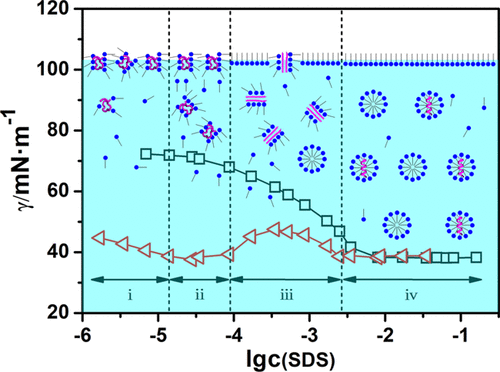Our official English website, www.x-mol.net, welcomes your
feedback! (Note: you will need to create a separate account there.)
Effects of Conventional Surfactants on the Activity of Designed Antimicrobial Peptide.
Langmuir ( IF 3.7 ) Pub Date : 2020-03-27 , DOI: 10.1021/acs.langmuir.0c00032 Kang Liu 1 , Liuxin Yang 1 , Xiaoting Peng 1 , Haoning Gong 2 , Jiqian Wang 1 , Jian Ren Lu 2 , Hai Xu 1
Langmuir ( IF 3.7 ) Pub Date : 2020-03-27 , DOI: 10.1021/acs.langmuir.0c00032 Kang Liu 1 , Liuxin Yang 1 , Xiaoting Peng 1 , Haoning Gong 2 , Jiqian Wang 1 , Jian Ren Lu 2 , Hai Xu 1
Affiliation

|
In this article, the interaction between a designed antimicrobial peptide (AMP) G(IIKK)3I-NH2 (G3) and four typical conventional surfactants (sodium dodecyl sulfonate (SDS), hexadecyl trimethyl ammonium bromide (C16TAB), polyoxyethylene (23) lauryl ether (C12EO23), and tetradecyldimethylamine oxide (C14DMAO)) has been studied through surface tension measurement and circular dichroism (CD) spectroscopy. The antimicrobial activities of AMP/surfactant mixtures have also been studied with Gram-negative Escherichia coli, Gram-positive Staphylococcus aureus, and the fungus Candida albicans. The cytotoxicity of the AMP/surfactant mixtures has also been assessed with NIH 3T3 and human skin fibroblast (HSF) cells. The surface tension data showed that the AMP/SDS mixture was much more surface-active than SDS alone. CD results showed that G3 conformation changed from random coil, to β-sheet, and then to α-helix with increasing SDS concentration, showing a range of structural transformation driven by the different interactions with SDS. The antimicrobial activity of G3 to Gram-negative and Gram-positive bacteria decreased in the presence of SDS due to the strong interaction of electrostatic attraction between the peptide and the surfactant. The interactions between G3 and C16TAB, C12EO23, and C14DMAO were much weaker than SDS. As a result, the surface tension of surfactants with G3 did not change much, neither did the secondary structures of G3. The antimicrobial activities of G3 were little affected in the presence of C12EO23, slightly improved by C14DMAO, and clearly enhanced by cationic surfactant C16TAB due to its strong cationic and antimicrobial nature, consistent with their surface physical activities as binary mixtures. Although AMP G3 did not show activity to fungus, the mixtures of AMP/C16TAB and AMP/C14DMAO could kill C. albicans at high surfactant concentrations. The mixtures had rather high cytotoxicity to NIH 3T3 and HSF cells although G3 is nontoxic to cells. Cationic AMPs can be formulated with nonionic, cationic, and zwitterionic surfactants during product development, but care must be taken when AMPs are formulated with anionic surfactants, as the strong electrostatic interaction may undermine their antimicrobial activity.
中文翻译:

常规表面活性剂对设计的抗菌肽活性的影响。
在本文中,设计的抗菌肽(AMP)G(IIKK)3 I-NH 2(G 3)与四种典型的常规表面活性剂(十二烷基磺酸钠(SDS),十六烷基三甲基溴化铵(C 16 TAB),通过表面张力测量和圆二色性(CD)光谱研究了聚氧乙烯(23)月桂基醚(C 12 EO 23)和十四烷基二甲基氧化胺(C 14 DMAO)。还已用革兰氏阴性大肠杆菌,革兰氏阳性金黄色葡萄球菌和白色念珠菌研究了AMP /表面活性剂混合物的抗菌活性。。还已使用NIH 3T3和人皮肤成纤维细胞(HSF)细胞评估了AMP /表面活性剂混合物的细胞毒性。表面张力数据表明,AMP / SDS混合物比单独的SDS具有更高的表面活性。CD结果表明,随着SDS浓度的增加,G 3构象从无规卷曲变为β-折叠,然后变为α-螺旋,显示出一系列与SDS相互作用而驱动的结构转变。在SDS的存在下,由于肽和表面活性剂之间的静电吸引作用很强,G 3对革兰氏阴性和革兰氏阳性细菌的抗菌活性降低。G 3和C 16 TAB,C 12 EO之间的相互作用23和C 14 DMAO比SDS弱得多。结果,具有G 3的表面活性剂的表面张力没有太大变化,G 3的二级结构也没有变化。在存在C 12 EO 23的情况下,G 3的抗菌活性受到的影响很小,由于C 14 DMAO的强阳离子和抗菌特性,与C 12 EOO的表面物理活性一致,因此C 14 DMAO对其略有改善,并且阳离子表面活性剂C 16 TAB明显增强了其抗菌活性。二元混合物。尽管AMP G 3对真菌没有活性,但AMP / C 16 TAB和AMP / C 14的混合物在高表面活性剂浓度下,DMAO可以杀死白色念珠菌。该混合物对NIH 3T3和HSF细胞具有相当高的细胞毒性,尽管G 3对细胞无毒。阳离子AMP可以在产品开发过程中与非离子,阳离子和两性离子表面活性剂一起配制,但是当AMP与阴离子表面活性剂一起配制时必须小心,因为强的静电相互作用可能会破坏其抗菌活性。
更新日期:2020-03-27
中文翻译:

常规表面活性剂对设计的抗菌肽活性的影响。
在本文中,设计的抗菌肽(AMP)G(IIKK)3 I-NH 2(G 3)与四种典型的常规表面活性剂(十二烷基磺酸钠(SDS),十六烷基三甲基溴化铵(C 16 TAB),通过表面张力测量和圆二色性(CD)光谱研究了聚氧乙烯(23)月桂基醚(C 12 EO 23)和十四烷基二甲基氧化胺(C 14 DMAO)。还已用革兰氏阴性大肠杆菌,革兰氏阳性金黄色葡萄球菌和白色念珠菌研究了AMP /表面活性剂混合物的抗菌活性。。还已使用NIH 3T3和人皮肤成纤维细胞(HSF)细胞评估了AMP /表面活性剂混合物的细胞毒性。表面张力数据表明,AMP / SDS混合物比单独的SDS具有更高的表面活性。CD结果表明,随着SDS浓度的增加,G 3构象从无规卷曲变为β-折叠,然后变为α-螺旋,显示出一系列与SDS相互作用而驱动的结构转变。在SDS的存在下,由于肽和表面活性剂之间的静电吸引作用很强,G 3对革兰氏阴性和革兰氏阳性细菌的抗菌活性降低。G 3和C 16 TAB,C 12 EO之间的相互作用23和C 14 DMAO比SDS弱得多。结果,具有G 3的表面活性剂的表面张力没有太大变化,G 3的二级结构也没有变化。在存在C 12 EO 23的情况下,G 3的抗菌活性受到的影响很小,由于C 14 DMAO的强阳离子和抗菌特性,与C 12 EOO的表面物理活性一致,因此C 14 DMAO对其略有改善,并且阳离子表面活性剂C 16 TAB明显增强了其抗菌活性。二元混合物。尽管AMP G 3对真菌没有活性,但AMP / C 16 TAB和AMP / C 14的混合物在高表面活性剂浓度下,DMAO可以杀死白色念珠菌。该混合物对NIH 3T3和HSF细胞具有相当高的细胞毒性,尽管G 3对细胞无毒。阳离子AMP可以在产品开发过程中与非离子,阳离子和两性离子表面活性剂一起配制,但是当AMP与阴离子表面活性剂一起配制时必须小心,因为强的静电相互作用可能会破坏其抗菌活性。











































 京公网安备 11010802027423号
京公网安备 11010802027423号